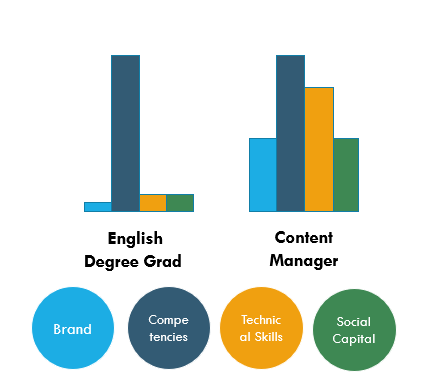#2 Career Foundations Series (Go Back to 1)
There’s a secret to being hireable that nobody teaches, and it took me a long time to learn it. When I see new grads trying to figure out how to get a job after college, it frustrates me–because most of us have never been taught what it takes to actually get hired.
What would you say if I told you that most people are WASTING their time with career-building? They get the same crappy advice on building a career: Train for the job you want, then build a resume and send it to thousands of people until someone hires you.
The real world doesn’t work like this.
I admit, I thought training and resume dumping was career-building 101.
And then, something happened. I started meeting ridiculously successful people in a ton of industries: CEOs, C-Suite leaders, politicians, founders, and people who were on the fast track towards amazing positions.
I still remember having to hire and pay consultants for a project I was running. The CEO called me into his office and made me write down a list of people from the top of his head that we should invite to be a part of the project, then he told me to reach out to them to see if they’d do it. We paid them too, offering $15,000 consulting fees up front to write a report.
They didn’t send us resumes.
None of the leaders I met followed the resume paradigm. But they were still getting jobs, constantly. And as I built my career, I started to get offers like this too.
I still remember the first time I was offered a job via text message that paid $100k+…
Hey Chris, Would you ever consider coming to join us? I need someone to put this program together and lead the policy development.
That’s it. That’s how it came.
And I realized that, by copying the leaders I knew, I was doing some things right without even realizing it. I used the lessons I learned from the experience to create a new framework for hireability, and I ESPECIALLY want new grads to hear this so they don’t waste their time.
Watch this post on YouTube OR Keep Reading Below!
The 4 Pillars of Hireability
If you’re a leader, if you want to catapult beyond entry-level crap and build the career you want, learn this secret to being hireable. It will change your life. P.S. It works just fine whether you want to become an employee or start your own business.
The 4 pillars are:
- Your Brand: How people perceive you as a professional–whether they read your resume, check your LinkedIn profile, or hear you speak.
- Your Social Capital: Your network and the relationships you have that will launch your career.
- Your Competencies: The things you’re good at, like managing people, resolving conflict, overseeing a project, or curing a disease.
- Your Technical Skills: The specific skills you have (usually hard skills), like coding, web design, photography, or welding. (Often your competencies involve using your technical skills.)
These are the 4 pillars you need to think about. They all work together, but different jobs require different combinations.
Let me show you want I mean…
Most people think that you get a job because you have competencies and technical skills–our whole education system is built on this. If you train to be a doctor, you learn about anatomy, sickness, etc, as well as technical skills to support these competencies (how to use a scalpel). If you train to be a teacher, you grow your knowledge and competencies (American History), and then use your technical skills to teach kids (public speaking, curriculum design).
This method of becoming hireable works great if you’re a mechanic or a plumber. But it doesn’t really help MOST careers.
Here’s why…
For most of us, hireability is a different combination of the 4 pillars.
Check this out…
As you can see from this chart, different jobs have different requirements.
I’ve met lobbyists who have little to their name except for the fact that they worked for a politician once and now have powerful connections on the Hill. They’re not being hired for their technical skills. After an election, when a lot of political staffers become unemployed, it would be ridiculous to tell one to go and train as a welder. Unless they REALLY want to change careers, they should leverage what they have: their social capital and networks of politicians. They’ll make BANK.
The way you’ve been taught to think about hireability is wrong! If you’re unemployed and looking for a career coach, you don’t care if they have technical skills. You want to know if they can get you the results you need–and their brand is going to be a part of that.
I get paid to speak. Why? Because I have a visible brand and I’m a good speaker–and often opportunities come through my network.
How to 10x Your Hireability
The bizarre paradox is that most people who want to get hired are doing the wrong things. Most grads who want to get started on a career, especially if their degree didn’t take them there, are thinking about upskilling.
And there’s NOTHING wrong with learning a new skill. Seriously, I love upskilling. I’ve taught myself the BEST skills that I use every day in digital marketing. (I even wrote this post about High Income Skills You Can Teach Yourself!)
But learning a new skill isn’t the place to start if you want to becoming more hireable. This chart will tell you why…
You can increase your Brand (AKA how people perceive you) quickly. Heck, brush up your LinkedIn profile and you’re doing part of that work.
You can increase your Social Capital FAST; have 3 conversations this week with people who work in an industry that’s interesting and you’ll increase your chances of getting hired 10x.
It takes time to develop Competence and Technical Skills. If you want to know how to design products, that’s going to take time. If you want to learn to code or to be a mechanic, it doesn’t happen overnight.
Now don’t get me wrong, I do think you should learn competencies and technical skills. But they take time (and honestly, the best way to learn competencies can be to get paid to do it on the job). I’d way rather see you get hired in a field that will move you towards your chosen end than flipping burgers and trying to retrain on the side.
Diagnosing Your Stuckness
Overall, you need different combinations of these 4 things for different fields. So if you want to figure out where your job searching is going wrong, start with this paradigm to diagnose it.
I was talking to someone the other day who is a web designer, and she’s trying to launch a career. She’s a great designer. So I had her look at the four pillars. She realized that she doesn’t need to take more courses to get better at design. She needs to focus on building her brand (her website and social presence) and building relationships with other designers, her target customers, etc.
A new grad who trained as an architect or as a lab researcher who is struggling to get jobs usually needs more social capital (ie. reaching out for informational interviews with someone in the desired field).
Students with liberal arts degrees often need to do some work to clarify what their competencies are and map the skills they have, in addition to building their network. After that, they can evaluate if they need to learn more skills to be more hireable.
For example, an English grad actually has a lot of the right competencies to be a Content Manager–a highly-paid and in-demand tech job (I wrote about it in this post). They might need to add some technical skills (ie. SEO, Digital Marketing), and work on their brand and social capital.

As you can see, it’s not a huge leap for this English grad to get a high-paying and in-demand job. But what do most English grads do when they finish and can’t find a job? They go back to school! This is totally wrong!
Conclusion
If you need to get a job fast, to launch your career this week, focus on the things you can do QUICKLY! As you build your career, take a holistic view of these four things and adapt accordingly. This paradigm will help you to get a job fast, but it will also help you through career shifts–it’s a life-long career framework. Use it well.. Good luck!



